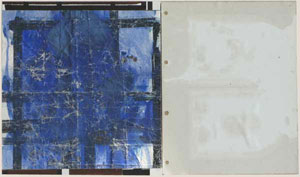De kern van mijn werk ligt in de herinnering van het terloops oppakken van een schelp aan het Noordzee strand. De ontroering, die ik kreeg bij het aandachtig kijken naar de binnenkant van deze schelp, heb ik nooit vergeten. Het was een ervaring van almachtige schoonheid, die mij deed beseffen dat alles te zien is in het kleine en zogenaamde alledaagse. Ik vond een stukje van het paradijs.
De huid - de pakbaarheid van het gewone, aardse stoffelijke - is daardoor een rode draad in mijn werk geworden. Ik ben een chirurg, die van uit het kleinste fragment de wereld tot in zijn details wil ontleden.
De stoffelijkheid van mijn werk komt terug in het gebruik van bv. teer, wol, fluweel, papier. De chirurg in mij fileert deze materialen en beperkt zich tot een paar beeldaspecten zoals lijn, kleur en textuur. Dit proces neemt de vorm aan van een DNA onderzoek. De herhaling van vorm en lijn leidt tot patronen en systemen waarin een autenthiek, volmaakt detail zich openbaart.
In ons dagelijks bestaan zijn het de essenties, die ons doen overleven en dat is uiterst intrigerend.
In 2004 en 2006 ben ik een aantal maanden in Zambia geweest. De aardse werkelijkheid in dat land is alom aanwezig. Wij beleven daar de essenties, die ons doen overleven en dat is uiterst intrigerend.
 |
|
In search of a small piece of paradise
The essence of my work lies in the memory of casually picking up a shell on a North Sea beach. I have never forgotten the emotion I felt when I looked closely at the inside of the shell. It was an experience of supreme beauty, which made me realize that everything can be seen in the small and everyday. I had found a small piece of paradise. Consequently, skin and through it the sensation of the ordinary material world, is a leitmotif in my work. I am a surgeon who, starting from the smallest fragment, wishes to dissect the world in all its detail.
The material aspect of my work is evident in the use, for example, of tar, wool, velvet and paper. The surgeon in me divides these materials and restricts himself to a few visual aspects such as line, colour and texture. The process takes on the form of a DNA analysis. The repetition of form and line leads to patterns and systems in which authentic and perfect detail is revealed.
In our daily life it is on the essentials that we depend for survival and that is most intriguing.
In 2004 and 2006 I spent several months in Zambia. In 2009, next year, I will visit this country again. The earthy reality of the country is present everywhere. While there I became aware that it is on the essentials that we depend for survival, and that is most intriguing.
_______________________________________________________________________________________
Citaat uit 'Those Barren Leaves' - Aldous Huxley 1925
Calamy went on. “And so these,” he said, “are some of the ways - and there are plenty more, of course, besides - these are some of the ways in which my hand exists and is real. This shape which interrupts the light - it is enough to think of it for five minutes to perceive that it exists simultaneously in a dozen parallel worlds. It exists as electrical charges: as chemical molecules; as living cells; as part of a moral being, the instrument of good and evil; in the physical world and in the mind. And from this one goes on to ask, inevitably, what relationship exists between these different modes of being. What is there in common between life and chemistry; between good and evil and electrical charges; between a collection of cells and the consciousness of a caress? It’s here that the gulfs begin to open. For there isn’t any connection - that one can see, at any rate. Universe lies on top of universe, layer after layer, distinct and separate..”
|


